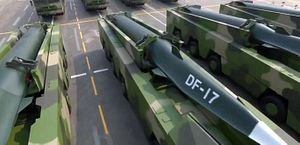But what is it that makes the DF-17 such an attraction and is it truly special?
Like most things, it depends.
These days, there’s a lot of hype around “hypersonic” weapons, but they have actually been around for some time. For instance, the first intercontinental ballistic missiles in the late-1950s and early-1960s saw their warheads reach hypersonic speeds.
And that’s really it: hypersonic is description of speed. The term refers to anything travelling at five-times the speed of sound or greater. In the contemporary setting, hypersonic missiles can be split into two categories: hypersonic cruise missiles and hypersonic boost-glide weapons.
The latter are more exotic and draw greater scrutiny. Unlike traditional ballistic missile re-entry vehicles, which are propelled to great heights by a booster rocket only to fall back to Earth on a roughly predictable trajectory, boost-glide vehicles leverage atmospheric lift and drag forces to glide – imagine a pebble skipping over the surface of a lake.
As they glide they accumulate tremendous heat and speed. To a limited degree, they can manoeuvre low to evade radars designed to look for high-flying missile re-entry vehicles outside the Earth’s atmosphere. Because they give such little warning, in the final moments of flight, the weapons can catch point defences – such as short-range missile defence systems – off guard.
In the case of the DF-17, China has looked to build up a highly precise system. U.S. analysis of the missile’s first tests in November 2017 found an impressive degree of precision – with the test units apparently striking within metres of their targets.
The announcer during this year’s National Day parade in Beijing emphasised that the DF-17 was a conventional-only weapon. That means that when it is deployed with the PLA Rocket Force, it won’t have a role in the delivery of nuclear weapons. That may change in the future, but the system’s precision will allow it to serve a useful conventional role for the Chinese military.
In a conflict, weapons like the DF-17 would pose a formidable challenge for the United States and its allies. For instance, rapid conventional strikes could disable critical U.S. command centres and even airfields along the first island chain.
U.S. officials have expressed concern about their inability to defend against these kinds of threats.
“We don’t have any defence that could deny the employment of such a weapon against us,” General John Hyten, who is now vice-chairman of the Joint Chiefs of Staff, said in March last year.
While efforts to develop hypersonic boost-glide weapon defences are underway, efforts remain in the preliminary stages.
The official clarification that the DF-17 remains conventional is an important stabilising step. Until China moves otherwise, U.S. planners will know in peacetime that DF-17 units, wherever they may be, will only serve a conventional warfighting role.
China’s development of the DF-17, along with Russia’s pursuit and deployment of a similar weapon known as the Avangard, have prompted interest in these kinds of capabilities in the U.S., and research and development into such weapons is ongoing.
The DF-17, in particular, stands at the vanguard of the newly modernized military, underscoring China’s proficiency with emerging technologies.

































